The Scoville scale, developed by pharmacist Wilbur Scoville in 1912, measures the pungency or "heat" of chili peppers and other spicy foods. Understanding where jalapeños fall on this scale helps cooks, food enthusiasts, and even casual consumers make informed decisions about their spice tolerance and recipe choices.
Understanding Jalapeño Heat Variability
Jalapeño peppers don't have a single fixed SHU value but rather exist within a range influenced by multiple factors. The 2,500-8,000 SHU measurement represents typical fresh jalapeños, but several elements can affect their actual heat level:
- Growing conditions: Soil composition, climate, and water availability significantly impact capsaicin production
- Maturity: Red jalapeños (fully ripe) tend to be hotter than green ones
- Stress factors: Plants under environmental stress often produce hotter peppers
- Varietal differences: Some cultivated jalapeño varieties are bred specifically for milder or hotter profiles
- Individual pepper variation: Even on the same plant, heat levels can differ between peppers
Comparing Jalapeño Heat to Other Common Peppers
Understanding jalapeño SHU values becomes more meaningful when compared to other peppers. The following table shows where jalapeños fit within the broader pepper heat spectrum:
| Pepper Type | Scoville Heat Units (SHU) | Heat Level Comparison |
|---|---|---|
| Bell Pepper | 0 SHU | 0 times jalapeño heat |
| Poblano | 1,000-2,000 SHU | 0.25-0.8 times jalapeño heat |
| Jalapeño | 2,500-8,000 SHU | 1x (baseline) |
| Serrano | 10,000-23,000 SHU | 1.5-3x jalapeño heat |
| Cayenne | 30,000-50,000 SHU | 4-6x jalapeño heat |
| Habanero | 100,000-350,000 SHU | 15-45x jalapeño heat |
Practical Implications of Jalapeño SHU Values
Knowing the scoville units for jalapeño peppers helps in practical kitchen applications. The 2,500-8,000 SHU range makes jalapeños versatile for various culinary uses:
- Cooking with jalapeños: Most recipes assume standard jalapeño heat levels. If using particularly hot specimens, consider removing seeds and membranes where most capsaicin concentrates
- Substitution guidance: When substituting jalapeños, remember that serranos are significantly hotter while poblanos offer milder alternatives
- Heat management: The wide SHU range explains why some jalapeños seem unexpectedly mild while others deliver surprising heat
- Preservation effects: Pickled jalapeños may taste milder due to vinegar's effect on capsaicin perception, not actual SHU reduction
Measuring Jalapeño Heat Accurately
While the Scoville scale provides a standardized measurement, modern methods have replaced the original subjective taste-testing approach. Today, high-performance liquid chromatography (HPLC) precisely measures capsaicinoid concentration, then converts to Scoville units using a mathematical formula.
For home cooks wondering about the actual heat level of their jalapeños, the most practical approach is:
- Cut a small piece from the pepper tip
- Touch it to your tongue (avoiding lips and eyes)
- Wait 30-60 seconds for full heat sensation
- Adjust usage accordingly in your recipe
Safety Considerations When Handling Hot Peppers
Working with jalapeños at their maximum 8,000 SHU level requires proper handling techniques:
- Always wear gloves when handling hot peppers, especially when removing seeds
- Avoid touching your face, particularly eyes, during preparation
- Wash hands thoroughly with soap after handling, even with gloves
- Use separate cutting boards for hot peppers to prevent cross-contamination
- If experiencing burning sensation, dairy products (milk, yogurt) neutralize capsaicin better than water
Why Understanding Jalapeño SHU Matters for Food Enthusiasts
The scoville heat unit measurement for jalapeño peppers isn't just trivia—it's practical knowledge that enhances culinary experiences. Recognizing that jalapeños occupy the mild-to-medium range (2,500-8,000 SHU) helps in recipe development, spice blending, and creating balanced flavor profiles.
Food scientists note that the human palate detects heat differently based on various factors including:
- Individual tolerance to capsaicin
- Temperature of the food (heat perception increases with temperature)
- Fat content (fatty foods can intensify heat sensation)
- Acidity levels (vinegar can initially suppress but later enhance heat)
Understanding these dynamics alongside the jalapeño scoville scale range allows for more precise spice control in cooking.
Common Questions About Jalapeño Heat Levels
What is the average SHU for a standard jalapeño pepper?
The average SHU for a standard jalapeño pepper falls around 5,000 units, though they typically range from 2,500 to 8,000 SHU. This average represents most commercially available fresh jalapeños found in grocery stores.
Why do some jalapeños taste much hotter than others?
Jalapeño heat variation stems from growing conditions, maturity level, and genetic factors. Stressors like drought or temperature extremes increase capsaicin production. Red jalapeños (fully ripe) often contain more capsaicin than green ones, and individual peppers on the same plant can vary significantly in heat level despite identical growing conditions.
How does the jalapeño scoville rating compare to other common peppers?
Jalapeños (2,500-8,000 SHU) are significantly milder than habaneros (100,000-350,000 SHU) but hotter than poblanos (1,000-2,000 SHU). They're approximately 1.5-3 times milder than serranos and 4-6 times milder than cayenne peppers. Bell peppers register at 0 SHU, making them completely non-spicy.
Does pickling jalapeños change their SHU value?
Pickling doesn't alter the actual SHU measurement of jalapeños, as capsaicin content remains unchanged. However, the vinegar solution can temporarily suppress heat perception on the tongue, making pickled jalapeños seem milder during consumption. The chemical heat measurement remains identical to fresh peppers.
Can you reduce the SHU of jalapeños through cooking?
Cooking doesn't reduce the actual SHU measurement, but it does affect heat perception. High heat can break down some capsaicin molecules, potentially reducing perceived heat. More significantly, incorporating jalapeños into dishes with dairy, sugar, or starch can distribute and moderate the heat sensation, making the overall dish seem less spicy even though the pepper's SHU value remains unchanged.











 浙公网安备
33010002000092号
浙公网安备
33010002000092号 浙B2-20120091-4
浙B2-20120091-4